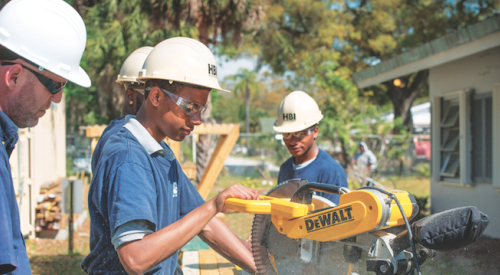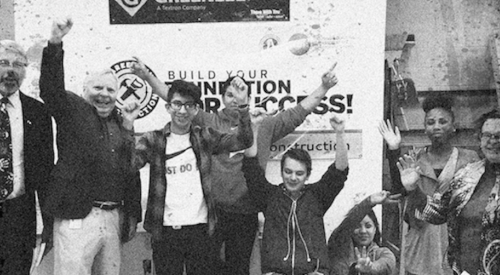| Job training for the construction trades is getting a boost from two new programs designed to encourage young people to consider home building as a viable career option.
|
Tired of sitting around, worrying about what labor shortages in the skilled construction trades are doing to your business? Well, get off your duff.
The housing industry is huge. Major corporations are just as imperiled by this labor crisis as the home builders -- large and small -- desperately trying to get houses built across the country. Two new national programs show that big corporate coalitions can aim massive funding firepower at attracting America's youth into the skilled construction trades.
For every entrepreneur with a business future tied to getting houses built, the message is clear: Think big. And get involved in these two programs at the local, state or national levels...they have the potential to put talented young people onto job sites.
Stanley Works manufactures tools for the building trades. Tools don't sell well when the numbers of skilled workers to use them are declining. Stanley is now the driving force behind a new SkillsUSA-VICA national competition called Team Build. It's not football. But it promises to enlist the same youthful enthusiasm that drives kids to compete under the banner of school pride. However, Team Build has the schools competing for a national championship in residential construction.
SkillsUSA-VICA is the national organization for high school and college vocational students in programs that support technical, skilled and service occupations. It has over 240,000 members annually, organized into nearly 13,000 chapters, in all 50 states and three U.S. territories (Puerto Rico, Guam, and the Virgin Islands).
The SkillsUSA National Championships, to be held this month in Kansas City, have grown from 54 competitors in three contests in 1967 to more than 4000 competitors in 70 skills and leadership contests. More than 12,000 students, teachers and business partners will attend the championships. Team Build is a 2000 addition.
The event will test technical skills in carpentry, masonry, electrical and plumbing trades, as well as organizational skills of the four contestants, who must work together as a team to build a segment of a house in the two-day competition. Each team will have to schedule the project, estimate materials and make a verbal presentation on its approach, then actually build the house segment from a standard set of plans given to all the teams.
"This first year it is by invitation only, with entrants from 10 states competing," says Tim Lawrence, SkillsUSA director of business and industrial partnerships.
"This is only a demonstration competition, to see how everything comes together," says Lawrence. "One thing we can say for sure is that this competition has a huge amount of industry support."
Start that list with Stanley Works, but it now also includes New England Classics, the Cahners Residential Group, which includes this magazine, and the Journal of Light Construction. Lawrence admits Team Build is driven by these corporate partners. "It's a little unusual. Normally, existing state and local championships create the need for a national championship. In this case, we are promoting an event that does not yet exist in most states. But we have championships in these trades.
"This event was Stanley Works' idea, to showcase home building as a team event. About 20 states now have schools that bring the building trades together and do team teaching. So we think this is a natural."
Next year, Lawrence anticipates that all states and territories will compete. "Eventually, we could have over 400 high school kids competing at the national championships, and an equal number in a separate college division."
To reach that goal, local and state competitions will have to be organized to deliver state champions to the national event. Obviously, there's plenty of room for builders, trade contractors, suppliers, and manufacturers to get involved in funding these competitions.
Kansas City builder Tom Woods, who serves nationally as chairman of Home Builders Institute, the educational arm of NAHB, and is also chairman of NAHB's labor shortages task force, thinks Team Build competitions are a great idea: "We have construction technology programs coming on stream in a lot of schools across the country," says Woods. "The kids will get excited about this. It taps their natural inclination toward team sports. If there are local, state and national championships, it will help the schools boost enrollments in the construction technology programs."
The second new national program is The Philip Polivchak Transition Fund, named to recognize the longtime president and CEO of Home Builders Institute. Though retired, Polivchak plans to spend some of his time in retirement raising money for the cause.
Like Team Build, The Phil Fund could have a profound and immediate impact on the flow of talented young people into the construction trades. The fund is designed to provide small amounts of money that Job Corps construction trades graduates need to start working in the industry. Job Corps is a rigorous training program for America's disadvantaged youth, funded by the U.S. Department of Labor for the past 35 years. It is a tough-love approach to breaking the poverty cycle afflicting mostly inner-city minority kids -- a group long recognized as an untapped labor resource.
"Job Corps is an unbridled success," says Keith Albright, HBI vice president of placement services. "For every dollar Uncle Sam invests in it, $1.46 is paid back by the students -- because they get jobs and go to work. There are over 100 vocations represented in 115 Job Corps training centers across the country. HBI has the contract to provide training in the construction trades in 67 centers.
"Job Corps programs are not nine-to-five. The students live and study at the centers 24 hours a day. It's like the military. They are up at 6 a.m., in chow line at 7 a.m. Rooms are inspected before they are allowed leave. They get both academic and trade training classes. If they don't measure up, they are booted out. Job Corps is no easy program."
However, problems arise when the new graduates, excited that they are now trained in a trade and ready to lift themselves out of poverty, face the daunting task of reaching the jobs that await them in the housing industry. Not many houses are built in the inner cities. The kids either have to relocate to the suburbs or buy cars to make long commutes.
"That's where The Phil Fund comes in," says Albright. "We have a placement fund, but it has been woefully inadequate. They leave Job Corps with some money and we get a copy of those checks, and receipts for all they buy.
But every employer requires employees to have transportation. Usually, these kids do not have enough to buy a car and auto insurance, or even the clothes and tools they need for the job."
The Phil Fund will provide a financial bridge to young people trained and ready to enter the construction work force. "Without this fund, we've watched a lot of kids give up, or be forced to flip burgers in a fast-food restaurant just to finance starting a trade job," he says. "With the labor shortages we face, it's just dumb not to get these Job Corps graduates working as fast as we can, while they are still excited about their prospects for a new life."
This magazine is underwriting The Phil Fund. Once again, the opportunity is there, for companies large and small, to contribute to the Philip Polivchak Transition Fund and have an immediate impact on the labor shortage. Do it now.












